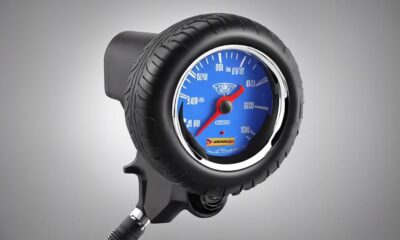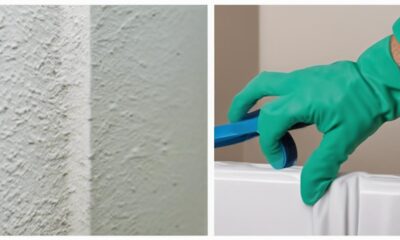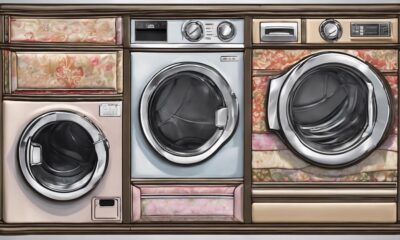Appliances
What Is the Winter Setting on a Ceiling Fan
2025
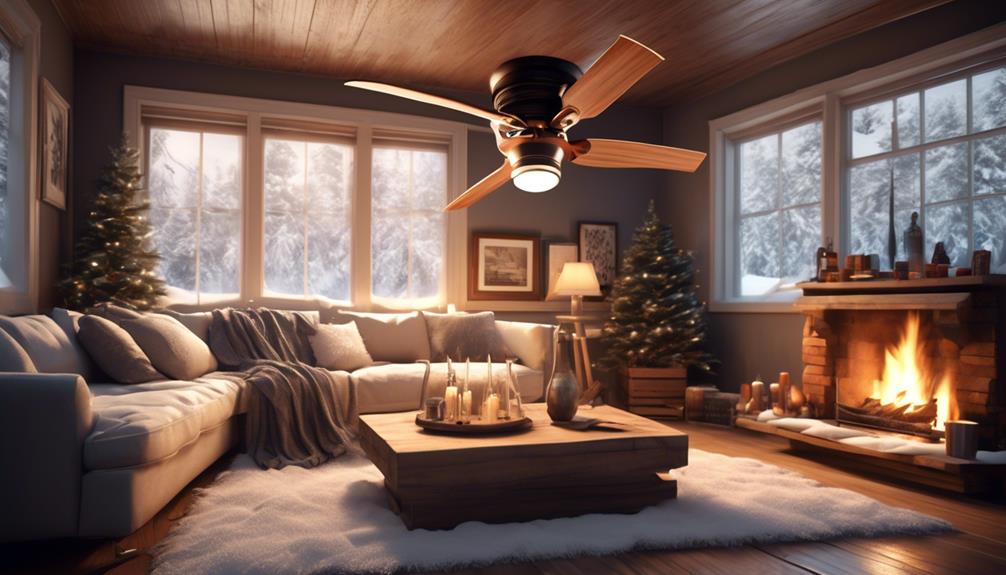
Throughout the winter season, a lot of us tend to adjust our thermostats to keep our living spaces warm and inviting. However, were you aware that your ceiling fan can contribute to preserving a pleasant temperature indoors?
That's where the winter setting on a ceiling fan comes in. This setting, often denoted by a switch on the fan's housing, allows you to change the direction of the fan blades. By utilizing the winter setting, the fan can help circulate warm air, making your space feel more comfortable without relying solely on your heating system.
In this article, we will explore the importance of the winter setting, how it works, its benefits, and some common misconceptions surrounding its use.
Key Takeaways
- The winter setting on a ceiling fan helps maintain comfort and energy efficiency during colder months.
- It redistributes warm air from the ceiling back down into the room, increasing comfort levels and reducing the need for additional heating.
- Using the winter setting saves energy by utilizing the ceiling fan to circulate warm air and prevents heat loss in rooms with high ceilings or poor insulation.
- The winter setting also enhances air quality by distributing fresh air, reducing allergens and pollutants, and creates a cozy and inviting atmosphere in living spaces.
Importance of the Winter Setting
The winter setting on a ceiling fan is an essential feature that plays a significant role in maintaining comfort and energy efficiency during the colder months. By utilizing the winter setting, you can maximize warmth in your living spaces while also saving energy.
During winter, warm air rises and collects near the ceiling, leaving the lower areas of the room feeling chilly. The winter setting on a ceiling fan helps to address this issue by reversing the direction of the fan blades. Instead of pushing air downwards, it gently pulls air upwards, creating an updraft. This updraft redistributes the warm air from the ceiling back down into the room, effectively increasing comfort levels and reducing the need for additional heating.
How the Winter Setting Works
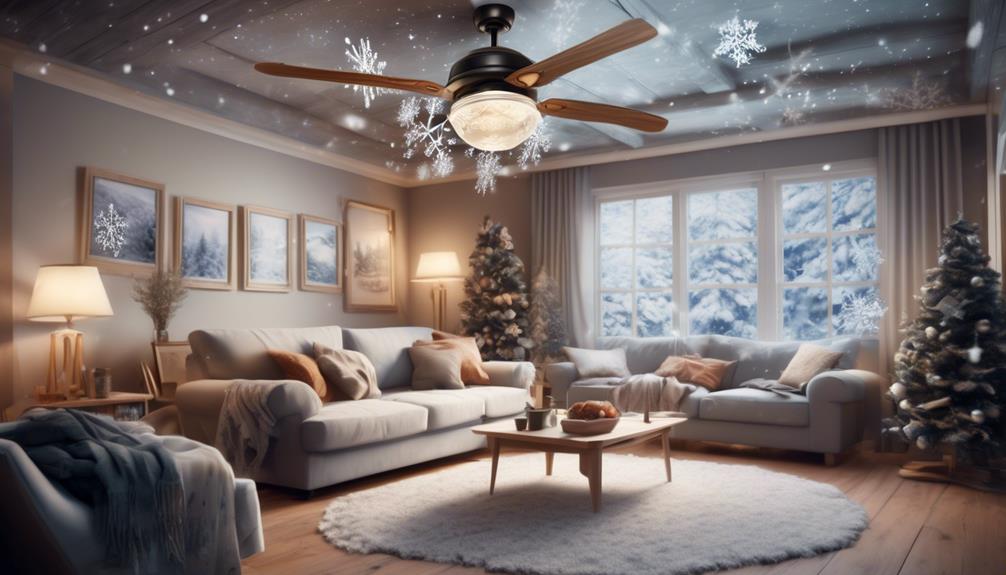
To understand how the winter setting on a ceiling fan works, it is important to grasp the concept of air circulation and the role it plays in maintaining a comfortable environment during colder months. The direction of rotation of a ceiling fan determines whether it is set for summer or winter use. In the summer, the fan should rotate counterclockwise to create a breeze that cools the room. However, in the winter, the fan should be set to rotate clockwise. This clockwise rotation helps to redistribute warm air that tends to rise and accumulate near the ceiling. By gently pushing the warm air back down towards the living space, the fan helps to maintain a more even temperature throughout the room.
Here is a table that illustrates the difference in the direction of rotation and the corresponding effect on heat distribution:
| Season | Direction of Rotation | Effect on Heat Distribution |
|---|---|---|
| Summer | Counterclockwise | Creates a cooling breeze |
| Winter | Clockwise | Redistributes warm air |
Direction of Fan Blades in Winter Mode
In winter mode, the direction of the fan blades is adjusted to maximize the redistribution of warm air throughout the room. By reversing the direction of the fan blades, the ceiling fan helps to prevent drafts and improve air circulation. In this mode, the fan blades rotate clockwise, as opposed to the usual counterclockwise rotation during the summer mode.
The clockwise rotation of the fan blades during winter mode creates an updraft that pushes the warm air near the ceiling down towards the floor. This helps to eliminate cold spots and prevents the warm air from accumulating near the ceiling, where it's of little use. By circulating the warm air downwards, the ceiling fan helps to evenly distribute the heat throughout the room, making it more comfortable and reducing the need for additional heating sources.
Furthermore, by improving air circulation, the ceiling fan in winter mode can also help to reduce energy consumption. When warm air is distributed more efficiently, the thermostat can be set at a lower temperature without sacrificing comfort. This can result in energy savings and lower heating costs.
Benefits of Using the Winter Setting

Using the winter setting on your ceiling fan offers several benefits.
First, it increases energy efficiency by circulating warm air throughout the room, allowing you to lower your thermostat and save on heating costs.
Second, it promotes better air circulation, preventing stagnant air and reducing the likelihood of mold and mildew growth.
Energy Efficiency
Using the winter setting on your ceiling fan can greatly improve energy efficiency.
The winter setting, also known as the reverse or clockwise setting, is designed to help with temperature regulation and cost savings during the colder months.
When the fan is set to the winter mode, it pushes the warm air trapped near the ceiling down towards the floor, creating a more even distribution of heat throughout the room.
This allows you to lower your thermostat and still maintain a comfortable temperature, resulting in cost savings on your energy bills.
The winter setting is especially beneficial in rooms with high ceilings or areas with poor insulation, as it helps to prevent heat loss and reduce the need for additional heating.
Air Circulation
By utilizing the winter setting on your ceiling fan, you can enhance air circulation and achieve optimal temperature regulation in your home during the colder months. This setting is designed to operate the fan in a clockwise direction, which helps to circulate the warm air that naturally rises to the ceiling.
Here are the benefits of using the winter setting:
- Improved Comfort: The circulating warm air prevents cold spots in your living space, ensuring a more comfortable environment.
- Energy Efficiency: By using the winter setting, you can reduce your reliance on heating systems, allowing you to save on energy costs.
- Enhanced Air Quality: Proper circulation helps in distributing fresh air and reducing the buildup of allergens, dust, and other pollutants.
Comfort and Warmth
To maximize comfort and warmth during the colder months, the winter setting on your ceiling fan is an effective solution. By utilizing this setting, you can regulate the temperature in your space while optimizing warmth.
The winter setting on a ceiling fan works by reversing the direction of the fan blades, causing the warm air that rises to be circulated back down to the living space. This prevents the warm air from accumulating near the ceiling and promotes even distribution throughout the room.
Energy-Saving Features of the Winter Setting
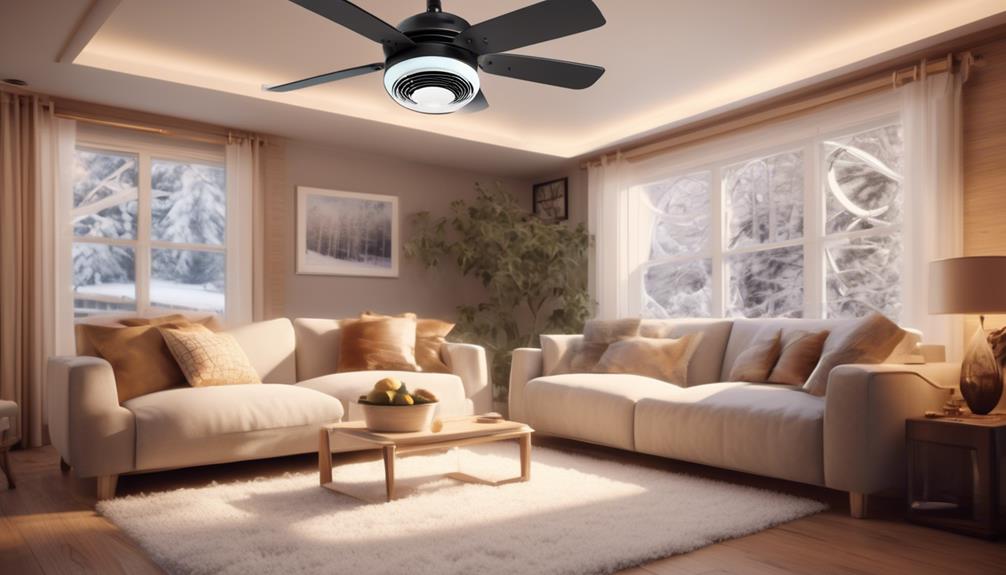
The winter setting of a ceiling fan incorporates energy-saving features that maximize efficiency during colder months. By utilizing these features, homeowners can improve air circulation and reduce heating costs.
Here are three important energy-saving features of the winter setting:
- Reverse Rotation: The winter setting allows the fan blades to rotate in the opposite direction compared to the summer setting. This helps to gently push warm air that naturally rises to the ceiling down towards the living space, resulting in improved heat distribution and reduced reliance on heating systems.
- Speed Control: Ceiling fans with a winter setting often come with multiple speed options. By adjusting the fan speed to a lower setting, homeowners can further optimize energy savings. Slower fan speeds ensure a gentle circulation of air without creating a draft, helping to maintain a comfortable and warm environment.
- Timer Function: Some ceiling fans with a winter setting offer a timer function, allowing users to set a specific duration for the fan to operate. This feature is particularly useful for those who prefer to have the fan run only for a certain period. By using the timer function wisely, homeowners can save energy by avoiding unnecessary fan operation.
Creating a Draft-Free Environment

After discussing the energy-saving features of the winter setting, we can now explore how to create a draft-free environment with a ceiling fan. Drafts can make a room feel colder, leading to discomfort and higher heating costs. By improving insulation and reducing drafts, we can achieve a more comfortable and energy-efficient space.
Firstly, it's important to assess the insulation in your home. Insufficient insulation can result in heat loss and drafts. Consider adding insulation to your walls, floors, and attic to minimize air leakage. This won't only help create a draft-free environment but also reduce your heating costs.
Next, seal any gaps or cracks around windows, doors, and electrical outlets. These small openings can allow cold air to enter and warm air to escape, creating drafts. Use weatherstripping or caulking to seal these gaps and prevent unwanted airflow.
In addition, using a ceiling fan in conjunction with a well-insulated room can further enhance draft reduction. Set your ceiling fan to rotate clockwise on the lowest speed. This will gently circulate the warm air trapped near the ceiling back down into the room. By redistributing the warm air, you can maintain a more consistent temperature and reduce the need for additional heating.
Improving Air Circulation in Winter

Let's now focus on improving air circulation in winter by considering three key points:
- Fan blade direction: Adjusting the fan blade direction to rotate clockwise helps to push warm air towards the ceiling and down the walls, creating a more even distribution of heat.
- Reverse switch function: Utilizing the reverse switch function allows the fan to operate in a clockwise direction, maximizing the circulation of warm air.
- Warm air distribution: By strategically placing fans around the room, we can enhance the movement of warm air and ensure a comfortable and efficient heating system.
Fan Blade Direction
To improve air circulation in winter, there are three key points to consider.
- Reverse the fan blade angle: By reversing the direction of your ceiling fan blades, you can push warm air down from the ceiling and create a more even distribution of heat throughout the room.
- Enhance air circulation patterns: Changing the fan blade direction helps to break up stagnant air pockets and prevent the buildup of condensation on windows and walls.
- Maximize energy efficiency: By utilizing your ceiling fan effectively, you can reduce your reliance on heating systems and save on energy costs.
Reverse Switch Function
When adjusting the reverse switch function on your ceiling fan, you can effectively improve air circulation in winter, allowing for a more comfortable and evenly heated environment.
The reverse switch benefits are often misunderstood, leading to common winter setting myths. By activating the reverse switch, the ceiling fan blades rotate in the opposite direction, creating an updraft that pushes warm air trapped near the ceiling down towards the floor. This helps to eliminate cold spots and prevents heat from being wasted.
Contrary to popular belief, the reverse switch doesn't cool the room but works in conjunction with your heating system to distribute warm air more efficiently.
It's important to note that the reverse switch function should only be used when the heating system is active.
Warm Air Distribution
Improving air circulation in winter can be achieved by activating the reverse switch on your ceiling fan. This feature enables the fan blades to rotate clockwise, creating a gentle updraft that redistributes warm air throughout the room. By utilizing warm air circulation, you can enhance temperature control and create a more comfortable environment during the colder months.
To optimize warm air distribution, consider the following tips:
- Set your ceiling fan to a low speed to avoid creating a draft.
- Ensure that the fan is running in the reverse direction, indicated by the switch being flipped in the opposite position.
- Keep the fan on consistently to maintain a consistent flow of warm air.
Enhancing Heat Distribution in the Room

One effective way to enhance heat distribution in the room is by adjusting the ceiling fan's rotation direction. By changing the rotation direction to run in a clockwise direction during winter, the ceiling fan can help maximize warmth and reduce heating costs.
When the fan rotates clockwise, it creates an updraft that pushes the warm air near the ceiling down towards the floor. This allows the warm air to circulate throughout the room, preventing it from accumulating near the ceiling and leaving the lower parts of the room cooler.
The clockwise rotation of the ceiling fan during winter also helps to break up any stagnant air pockets that may form in the room. This promotes better air circulation and ensures that the warm air is evenly distributed, reducing the need for additional heating sources.
This adjustment can be made by simply flipping the switch on the fan's motor housing to change the rotation direction.
Ideal Temperature Settings for Winter Mode

When it comes to the ideal temperature settings for winter mode on your ceiling fan, there are a few key points to consider.
First, energy-efficient heating options can help you save on your utility bills while keeping your home cozy.
Second, utilizing the winter mode on your ceiling fan can help distribute heat evenly throughout the room, maximizing its effectiveness.
Lastly, we'll provide temperature control tips to help you find the perfect balance between comfort and energy savings.
Energy-Efficient Heating Options
To achieve optimal energy efficiency during the winter months, it's advisable to set your thermostat to a lower temperature when using energy-efficient heating options. This not only helps reduce energy consumption but also saves you money on your heating bills.
Here are three energy-efficient heating solutions to consider:
- Programmable thermostats: These allow you to set different temperatures for different times of the day, ensuring that you only heat your home when needed.
- Insulation: Proper insulation helps retain heat inside your home, reducing the need for constant heating.
- Zone heating: Instead of heating your entire home, zone heating allows you to heat specific areas or rooms, saving energy and resources.
Benefits of Winter Mode
Using the winter mode setting on your ceiling fan can provide numerous benefits during the colder months.
One of the key advantages is improving insulation in your home. When the fan is set to winter mode, it rotates in a clockwise direction at a low speed. This gentle circulation of air helps to push warm air that naturally rises to the ceiling back down towards the living space.
As a result, the temperature in the room becomes more even and comfortable. By redistributing warm air, the winter mode setting can also help to reduce heating costs.
With improved air circulation, your heating system doesn't have to work as hard to maintain a consistent temperature, leading to potential energy savings.
Temperature Control Tips
To optimize the benefits of the winter mode setting on your ceiling fan, it's important to choose the ideal temperature settings for maximum comfort and energy efficiency. When setting the ideal temperature, keep in mind that every degree matters.
Here are some temperature control tips to help you reduce heating costs while staying cozy:
- Set the thermostat to a lower temperature when you're asleep or away from home. A reduction of just a few degrees can result in significant energy savings.
- Use a programmable thermostat to automatically adjust the temperature based on your schedule. This ensures that your home is warm when you need it and saves energy when you don't.
- Consider layering clothing and using blankets to stay warm instead of cranking up the heat. This allows you to maintain a lower temperature setting while still feeling comfortable.
Adjusting Fan Speed for Optimal Comfort
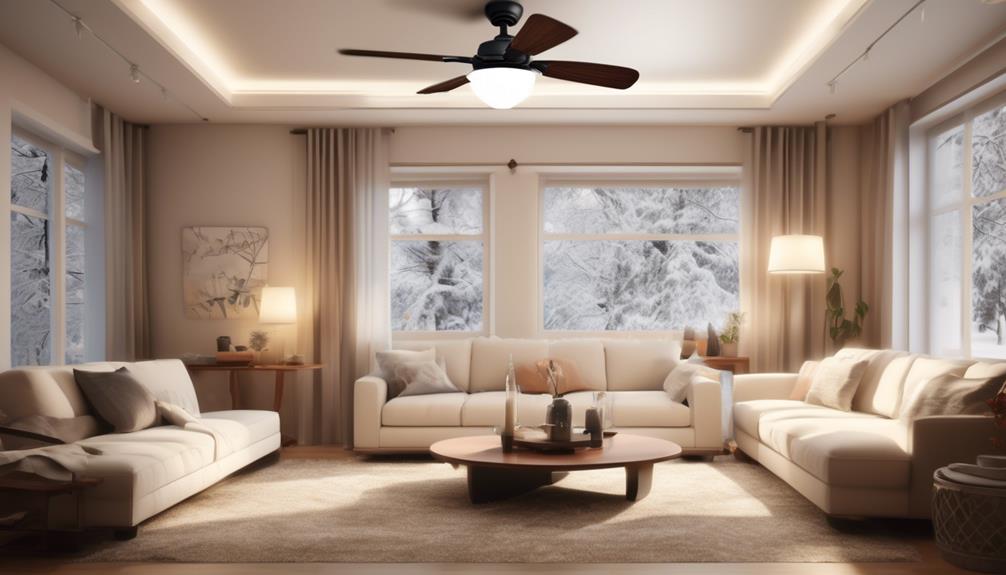
Adjust the speed of your ceiling fan for optimal comfort by utilizing the various settings available. By adjusting the fan speed, you can create a pleasant airflow that helps to regulate the temperature in your room. This is especially useful during the winter months when you want to distribute warm air evenly throughout the space.
To help you understand the different fan speed settings, refer to the table below:
| Speed Setting | Description | Best Use |
|---|---|---|
| Low | Gentle breeze | Ideal for maintaining a comfortable temperature in a small room. |
| Medium | Moderate airflow | Suitable for larger rooms or areas where you need a balanced cooling effect. |
| High | Strong airflow | Effective for quickly cooling down a room or providing ventilation in a stuffy space. |
When adjusting the fan speed, consider factors such as room size, temperature preferences, and personal comfort. Keep in mind that using a ceiling fan does not replace the need for adjusting the thermostat or using space heaters. Rather, it complements these temperature control methods by improving air circulation and creating a more comfortable indoor environment.
Using the Winter Setting in Different Rooms
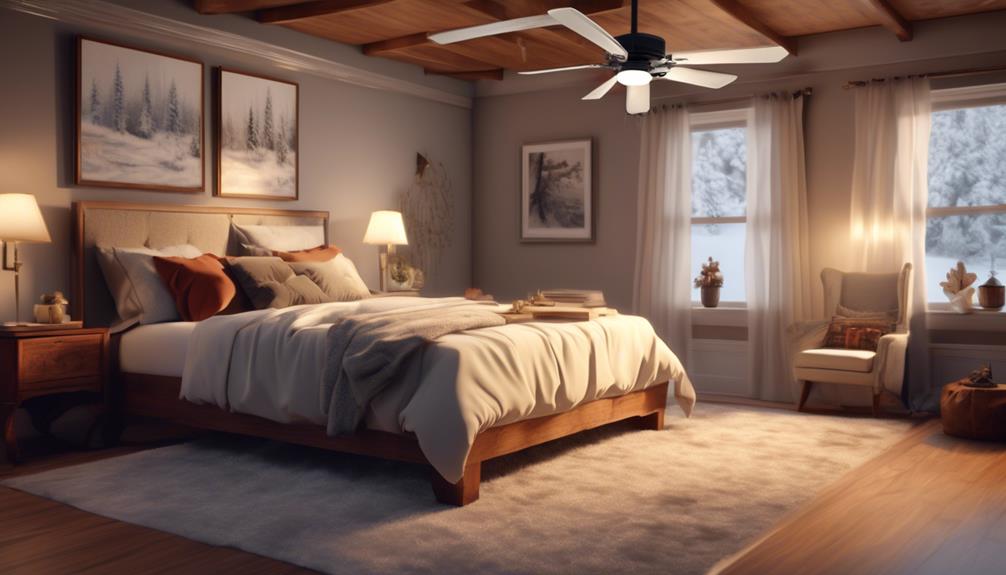
As we explore the winter setting in different rooms, it's important to consider how adjusting the ceiling fan speed can optimize airflow and maintain a comfortable temperature throughout your home. The winter setting on a ceiling fan is designed to help distribute warm air, allowing you to lower your thermostat and save on heating costs.
Here are some key considerations when using the winter setting for temperature control and optimizing fan speed in different rooms:
- Room Size: Adjusting the fan speed based on the size of the room is crucial. In larger rooms, setting the fan speed to a higher setting will help circulate warm air more effectively. For smaller rooms, a lower fan speed will suffice.
- Ceiling Height: The height of the ceiling also plays a role in optimizing fan speed. For rooms with higher ceilings, increasing the fan speed will help ensure the warm air is evenly distributed throughout the space.
- Direction of Rotation: The winter setting typically involves running the fan in a clockwise direction. This helps push warm air trapped near the ceiling down to the floor, creating a more comfortable environment.
Maintenance Tips for the Winter Setting
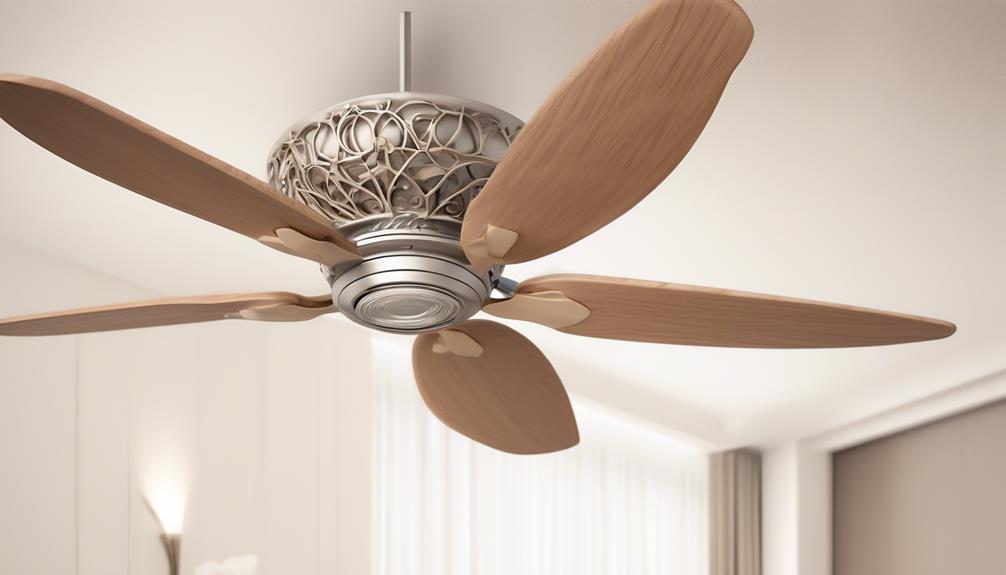
Now let's talk about some important maintenance tips for the winter setting of your ceiling fan.
By properly maintaining your fan, you can ensure optimal performance and energy-saving benefits throughout the colder months.
One key aspect is to make sure the fan is set to rotate clockwise, as this will help circulate warm air trapped near the ceiling back down into the room.
Energy-Saving Benefits
To maximize energy efficiency during the winter months, it's advisable to properly maintain the ceiling fan. By doing so, you can enjoy several energy-saving benefits and effectively control the temperature in your home. Here are some maintenance tips for the winter setting:
- Clean the fan blades regularly to ensure optimal airflow and efficiency.
- Reverse the direction of the fan blades to clockwise. This will create an updraft, pushing warm air down and redistributing it throughout the room.
- Adjust the fan speed to a low setting. This will help circulate the warm air without causing a cooling effect.
Proper Fan Direction
Proper maintenance of the ceiling fan during the winter setting includes ensuring the fan blades are cleaned regularly for optimal airflow and efficiency. In addition to cleaning, it is crucial to set the fan direction correctly to maximize its performance during the colder months. By adjusting the fan direction, you can enhance temperature control and achieve energy savings. To help you understand the proper fan direction for winter, refer to the table below:
| Fan Speed | Proper Direction | Benefits |
|---|---|---|
| Low | Clockwise | Gentle circulation of warm air throughout the room |
| Medium | Clockwise | Efficiently distributes warm air without creating drafts |
| High | Clockwise | Powerful dispersal of warm air, ideal for larger spaces |
Common Misconceptions About the Winter Setting

There are several common misconceptions surrounding the winter setting of a ceiling fan. Let's debunk these common myths and shed light on the truth about the winter setting:
- Myth 1: The winter setting generates heat. Contrary to popular belief, the winter setting on a ceiling fan doesn't produce heat. It simply redistributes the warm air that rises to the ceiling, allowing it to circulate back down into the room, creating a more even temperature.
- Myth 2: The winter setting is only for cold climates. The winter setting of a ceiling fan can be beneficial in any climate, whether it's cold or mild. By using the winter setting, you can maximize energy efficiency and reduce heating costs by making your heating system work more efficiently.
- Myth 3: The winter setting should always be on high speed. While it's true that using a higher fan speed in winter can help with air circulation, it's not always necessary. In fact, using a lower speed setting can be more than sufficient to achieve the desired effect without creating a draft or causing discomfort.
Other Uses for the Winter Setting

Now that we've debunked the common myths surrounding the winter setting of a ceiling fan, let's explore the various other uses for this setting.
In addition to cooling during the summer months, the winter setting on a ceiling fan can be utilized to maximize warmth and enhance energy efficiency in your home.
One of the main benefits of using the winter setting is its ability to circulate warm air throughout a room. By setting your fan to run in a clockwise direction at a low speed, you can help distribute the warm air that naturally rises to the ceiling. This can be particularly useful in rooms with high ceilings or areas where heat tends to gather, such as near a fireplace or radiator.
Using the winter setting on your ceiling fan can also help you save on energy costs. By circulating the warm air, you can maintain a more consistent temperature throughout the room, allowing you to lower your thermostat and still feel comfortable. This can lead to significant energy savings over time.
To maximize the benefits of the winter setting, it's important to ensure that your ceiling fan is clean and in good working condition. Regular maintenance, such as dusting the blades and ensuring proper balance, can help optimize its performance and efficiency.
Frequently Asked Questions
Can I Use the Winter Setting on My Ceiling Fan During the Summer Months?
Yes, you can use the winter setting on your ceiling fan during the summer months. The winter setting on a ceiling fan is designed to redistribute warm air that rises to the ceiling back down into the room.
However, it's important to note that using the winter setting during summer won't provide the same level of cooling as the regular fan setting.
Regular ceiling fan maintenance and energy efficiency practices should still be followed to ensure optimal performance and energy savings.
Will Using the Winter Setting on My Ceiling Fan Help Reduce My Heating Bills?
Using the winter setting on a ceiling fan can be an effective way to reduce heating costs.
By reversing the direction of the fan blades, the warm air that rises to the ceiling is pushed back down into the room.
This helps to distribute the heat more evenly and prevents it from escaping through the ceiling.
The winter setting on a ceiling fan can be a cost-saving option during the colder months, maximizing the efficiency of your heating system.
How Does the Winter Setting on a Ceiling Fan Affect the Airflow in the Room?
When it comes to the winter setting on a ceiling fan, we've got the scoop on how it affects the airflow in the room.
This setting is designed to improve air circulation, helping to distribute warm air throughout the space. By running the fan in reverse, it pushes the air upwards, which then circulates back down along the walls.
This clever trick can enhance energy efficiency by reducing the need for excessive heating, ultimately saving you some hard-earned cash on those heating bills.
Can Using the Winter Setting on My Ceiling Fan Help Prevent Condensation on Windows?
Using the winter setting on a ceiling fan can indeed help prevent condensation on windows. This is because the winter setting, which rotates the fan blades clockwise, creates an updraft that pushes warm air downwards and circulates it throughout the room.
Are There Any Safety Concerns or Precautions to Keep in Mind When Using the Winter Setting on a Ceiling Fan?
When using the winter setting on a ceiling fan, there are a few safety concerns and precautions to keep in mind.
First, make sure the fan is securely mounted to prevent it from falling.
Second, keep the fan blades clean and free of dust to avoid any potential fire hazards.
Lastly, ensure that the fan is operating smoothly and there are no loose parts that could cause injury.
It's also important to note that using the winter setting can improve energy efficiency by distributing warm air throughout the room.
How Does the Winter Setting on a Ceiling Fan Impact Speed Control and Installation?
The winter setting on a ceiling fan impacts the speed control and installation. Ceiling fan speed control installation in the winter helps to circulate warm air throughout the room. Installation of the fan in the correct direction and adjusting the speed control can help improve energy efficiency and overall comfort during colder months.
Do Ceiling Fans Have Different Settings for Different Seasons?
Yes, ceiling fans do have different settings for different seasons. In the summer, setting the fan to rotate counterclockwise on the highest speed helps create a cool breeze. In the winter, setting the fan to rotate clockwise on a low speed helps distribute warm air from the ceiling fan ac meaning efficiently.
Conclusion
In conclusion, the winter setting on a ceiling fan is a valuable feature that can help save energy and keep your home comfortable during the colder months.
By reversing the direction of the fan blades, the winter setting pushes warm air down from the ceiling, creating a cozy environment.
Just like a warm blanket on a chilly night, the winter setting provides a metaphorical embrace for your home, ensuring a snug and inviting atmosphere throughout the winter season.
- About the Author
- Latest Posts
Introducing Ron, the home decor aficionado at ByRetreat, whose passion for creating beautiful and inviting spaces is at the heart of his work. With his deep knowledge of home decor and his innate sense of style, Ron brings a wealth of expertise and a keen eye for detail to the ByRetreat team.
Ron’s love for home decor goes beyond aesthetics; he understands that our surroundings play a significant role in our overall well-being and productivity. With this in mind, Ron is dedicated to transforming remote workspaces into havens of comfort, functionality, and beauty.
Garage Door Opener
DIY: Install Garage Door Opener Keypad in 10 Steps
Journey into seamless garage access with our 10-step guide to installing a keypad – unlocking convenience at your fingertips.

When it comes to improving the functionality of your garage door system, adding a keypad can offer a convenient way to enter your garage.
However, the process of installing one might seem daunting at first glance. But fear not, as we have broken down the steps into a clear and concise guide that will have you confidently tackling this project in no time.
Stay tuned for essential tips and tricks that will ensure a smooth installation process and have you enjoying the convenience of your newly installed keypad in no time.
Key Takeaways
- Plan and prepare tools and location for keypad installation with attention to accessibility and visibility.
- Protect the keypad from weather elements with proper positioning and a weatherproof cover.
- Program the keypad securely, ensuring alignment and stability for optimal performance.
- Verify wiring connections, test the keypad's functionality, and finalize installation with thorough checks for proper operation.
Gather Required Tools and Materials
To begin the installation process smoothly, ensure we've all the necessary tools and materials at hand, such as a screwdriver, screws, and the keypad itself. When gathering these items, make sure they're compatible with your specific garage door opener model. It's crucial to have everything organized and easily accessible outside the garage where the installation will take place. Check the contents of the keypad box to confirm all components are included, avoiding any setbacks during the setup. Having a stable surface to lay out the tools and materials will facilitate quick access and prevent any potential mishaps.
Proper preparation is key to a successful installation. By ensuring we've the correct tools and materials ready beforehand, we can make the process more efficient and eliminate unnecessary delays. By double-checking and gathering all necessary items outside the garage, we set the stage for a smooth and hassle-free installation of the garage door opener keypad.
Locate the Ideal Placement

When choosing the ideal placement for your garage door opener keypad, we need to consider a few key points.
Ensure the keypad is strategically positioned for easy access by all users, at a comfortable height.
Additionally, think about weather protection to prolong the keypad's lifespan.
Choose Strategic Position
For optimum accessibility and ease of use, position the keypad at a height that caters to both adults and children while ensuring comfortable operation.
When choosing the strategic position for the garage door opener keypad, consider installing it at a level that's easily reachable for all users. Ensure the keypad isn't too high or too low, allowing for convenient operation without straining or bending.
Take note of any potential obstructions or interferences in the selected mounting location to avoid issues with functionality. Additionally, aim to place the keypad in a well-lit area that provides clear visibility for entering the pin code, enhancing user experience and security.
Consider these factors to determine the ideal placement for the keypad to optimize its functionality within your garage.
Ensure Easy Access
Positioning the garage door opener keypad at a height accessible to all users, typically around 5 feet from the ground, ensures convenient and easy access for efficient operation.
Placing the keypad in a well-lit area enhances visibility, especially during nighttime use. Be mindful of obstructions or sharp edges that could obstruct the keypad's functionality and accessibility.
Opt for a location shielded from extreme weather conditions to prolong the keypad's lifespan. Validate the keypad's placement by testing it from various entry angles to guarantee effortless access.
Consider Weather Protection
After ensuring easy access for efficient operation, the next crucial step is to consider weather protection when locating the ideal placement for your garage door opener keypad. To shield the keypad from direct exposure to rain, snow, or extreme weather conditions, it is advisable to install it in a sheltered area. Look for spots under an eave or a covered porch to extend the keypad's lifespan. If mounting the keypad in an exposed area, consider weatherproofing it with a protective cover or housing. Choosing a location that minimizes contact with water and moisture is key to prevent damage and maintain functionality over time. Ensuring weather protection for the keypad is essential for outdoor installations to uphold performance and longevity.
| Placement | Protection |
|---|---|
| Under an eave | Shield from rain and snow |
| Covered porch | Protection from extreme weather |
| Weatherproof cover | Prevent direct exposure to moisture |
Prepare the Keypad Mounting Surface

To ensure a secure and professional installation, start by cleaning the mounting surface with a damp cloth to remove any dirt or debris that may affect the keypad's adherence.
Once the surface is clean, use a level to ensure it's flat before proceeding with the installation. This step is crucial in achieving a polished and secure finish for your keypad.
Additionally, consider using a stud finder to locate and mark the studs on the wall. This will provide added support when mounting the keypad, ensuring it stays securely in place.
It's important to avoid mounting the keypad near any moving parts of the garage door to prevent interference or damage during operation.
Lastly, double-check the mounting surface for stability and suitability before proceeding with the installation to avoid any potential issues down the line.
Following these steps will help you set up your keypad efficiently and effectively.
Install Batteries in the Keypad

Let's start by checking the keypad manual for the specific 9-volt battery needed and opening the battery compartment accordingly.
Make sure to insert the battery following the polarity markings inside the compartment and securely close it for proper functionality.
Testing the keypad afterward will confirm the correct installation of the battery and ensure the keypad is ready for use.
Battery Installation Process
For optimal keypad performance, ensure the correct batteries are installed according to the manufacturer's specifications. Here's how to install the batteries properly:
- Check the Keypad Manual: Look up the specific battery requirements, typically 9-volt or AAA batteries, in the manual.
- Open the Battery Compartment: Use a screwdriver or follow the keypad's sliding mechanism to access the battery compartment.
- Insert Batteries Correctly: Pay attention to the polarity markings inside the compartment and insert the batteries accordingly.
- Securely Close the Compartment: Ensure the battery compartment is closed securely to establish proper connection and functionality.
Remember to replace the batteries periodically to maintain peak performance for your keypad.
Powering Up the Keypad
After successfully installing the batteries in the keypad, the next step is to power up the device by closing the cover securely to ensure proper functionality. To emphasize the importance of battery maintenance and replacement, here is a table outlining key points:
| Battery Maintenance Tips | |
|---|---|
| 1. Check battery life regularly | 2. Ensure proper polarity alignment |
| 3. Replace batteries promptly when low | 4. Avoid mixing old and new batteries |
| 5. Keep the battery compartment clean and dry | |
Following these guidelines will help maintain the keypad's efficiency and prevent operational issues. Remember, a well-powered keypad is essential for seamless garage door opener functionality.
Program the Keypad With Your Opener

To program the keypad with your opener, locate the colored learn button near the motor unit of the garage door opener. Different colors of learn buttons indicate specific programming methods for the keypad. Follow the manufacturer's instructions, as they typically involve a sequence of button presses to initiate programming mode.
Here are the steps to program the keypad accurately:
- Identify the color of the learn button on your garage door opener.
- Enter the programming mode by pressing the designated buttons on the keypad.
- Input a four-digit pin that you'll use to operate the keypad.
- Press the learn button on the garage door opener to synchronize the keypad with the opener.
It is crucial to test the programmed keypad by entering the pin and operating the garage door. This ensures successful synchronization and allows you to verify that the keypad is working correctly with your garage door opener.
Secure the Keypad in Place

Let's ensure the keypad is securely fastened in place by carefully aligning it with the level before tightening the screws evenly. Ensuring the keypad is straight is crucial to prevent any future issues, such as misalignment or difficulties in using the keypad. Here is a handy table to guide you through securing the keypad:
| Step | Action |
|---|---|
| 1 | Use a level to check alignment. |
| 2 | Tighten screws evenly for stability. |
| 3 | Confirm snug fit against the wall. |
Connect the Wiring to the Opener

Let's now tackle the crucial step of connecting the wiring to the opener.
We'll provide an overview of the wiring connections, ensure proper wire termination, and test the connection for functionality.
This process is vital to ensure your keypad communicates effectively with the garage door opener.
Wiring Connections Overview
Before proceeding with the wiring connections for the keypad installation, ensure that the power to the garage door opener is turned off.
Here's an overview of the wiring connections process:
- Identify the terminals on the garage door opener where the keypad wiring will be connected.
- Match the keypad wires to the corresponding terminals on the opener based on the installation instructions.
- Use wire nuts to securely connect the keypad wires to the opener terminals for a reliable connection.
- Double-check the wiring connections to ensure they're properly seated and insulated before restoring power to the opener.
Proper Wire Termination
Have the wire strippers handy to carefully remove the insulation from the ends of the keypad wires before matching them to the corresponding terminals on the garage door opener.
Ensure to match the colors of the keypad wires to the designated terminals on the opener.
Insert each wire into its assigned terminal and securely tighten the screws to establish a reliable connection.
It's crucial to double-check all connections to confirm there are no loose wires or exposed copper, which could lead to electrical hazards.
Adhering to the manufacturer's guidelines for wire termination is essential to prevent any operational issues.
Following these steps diligently will help guarantee a safe and efficient installation of your garage door opener keypad.
Testing the Connection
After securely connecting the keypad wiring to the designated terminals on the garage door opener, the next crucial step is to test the connection to ensure proper functionality before finalizing the installation. Here are four essential steps to follow:
- Activate the Keypad: Press a few random numbers on the keypad to check if the display lights up and responds.
- Test with the Opener: Enter the access code followed by the open/close button to see if the garage door responds accordingly.
- Check for Consistency: Repeat the process multiple times to confirm consistent operation.
- Inspect for Errors: Look for any error codes or unusual behavior during testing to address any potential issues promptly.
Test the Keypad Functionality

To ensure the smooth operation of the keypad, thoroughly test its functionality by pressing all buttons to confirm responsiveness and entering the programmed PIN for seamless garage door control. When testing the keypad, ensure that each button responds promptly and accurately to your touch. Next, input the programmed PIN to verify that the garage door opens and closes as intended. Additionally, check if the keypad illuminates correctly for easy use in different lighting conditions. Look out for any error messages or beeping sounds that could signal problems with programming or connectivity. Evaluate the keypad's range by testing its operation from various distances to guarantee reliable performance.
| Keypad Functionality Test | ||
|---|---|---|
| Button Responsiveness | Programmed PIN Entry | Illumination Check |
| Error Message Detection | Range Evaluation |
Adjust Keypad Settings as Needed

Let's seamlessly continue our installation process by adjusting the keypad settings as needed for added security and convenience. Here are some essential adjustments you may want to consider:
- Change Pin Code: Enhance security by customizing the four-digit pin code on the keypad regularly.
- Customize Features: Take control of additional garage door opener features, such as lights, by customizing the keypad settings to suit your preferences.
- Time Delay Feature: Prevent accidental activation of the garage door opener by setting up a time delay feature on the keypad.
- Vacation Mode: Enable vacation mode on the keypad to disable remote access when you're away for an extended period, enhancing the security of your garage.
Remember to refer to the manufacturer's instructions for adjusting advanced settings on the keypad to ensure optimal performance.
Enjoy Your Newly Installed Keypad

Upon completing the installation of your new keypad, take a moment to familiarize ourselves with its functions and button layout for seamless operation. Understanding how each button corresponds to specific actions will enhance your experience with the keypad.
Test its functionality multiple times to ensure it consistently works as expected. Consider setting up temporary access codes for guests or service providers to make entry more convenient.
It's essential to keep the keypad clean and free from debris to maintain its functionality over time. Remember to note down the keypad's location and pin code for future reference or troubleshooting purposes.
Frequently Asked Questions
Can I Add a Keypad to Existing Garage Door Opener?
Yes, we can add a keypad to an existing garage door opener. It's a straightforward process that enhances security and provides keyless entry.
Keypads work with various garage door opener brands and models. This upgrade is cost-effective and seamlessly integrates into your current setup with proper installation and programming.
Enjoy the convenience and peace of mind that a keypad brings to your garage door system.
Which Is Better Wired or Wireless Garage Door Keypad?
When it comes to choosing between a wired or wireless garage door keypad, it's essential to weigh the pros and cons.
Wired keypads offer reliability without battery reliance, but may need professional installation due to wiring requirements.
On the other hand, wireless keypads provide flexibility and are easier to install DIY.
Understanding your preferences and garage door opener setup will help determine which option suits you best.
Can You Hardwire a Garage Door Keypad?
Yes, we can hardwire a garage door keypad. It involves connecting the keypad directly to the power source of the garage door opener for a reliable power supply. Check the keypad's instructions to confirm hardwiring compatibility and follow the correct steps.
This method offers a more stable power source than batteries, but it may not be essential for all setups. Hardwiring is an option for those seeking a consistent power solution.
Can You Install a Garage Door Opener by Yourself?
Yes, we can install a garage door opener by ourselves. It's a manageable task with the right tools and instructions. Doing it independently can save us money and give us a sense of accomplishment.
Before starting, ensure the opener is compatible with our system. Following step-by-step guides is key to success. With attention to detail and patience, most of us can tackle this project successfully and enjoy the convenience of a keypad entry system.
Conclusion
In conclusion, with our 10-step guide, installing a garage door opener keypad can be a straightforward DIY project that adds convenience to your daily routine.
Remember, 'measure twice, cut once' to ensure accuracy and precision during the installation process.
By following our detailed instructions and taking your time to do it right, you can enjoy the benefits of easy access to your garage with just a few simple clicks.
Happy keypad installing!
- About the Author
- Latest Posts
Introducing Ron, the home decor aficionado at ByRetreat, whose passion for creating beautiful and inviting spaces is at the heart of his work. With his deep knowledge of home decor and his innate sense of style, Ron brings a wealth of expertise and a keen eye for detail to the ByRetreat team.
Ron’s love for home decor goes beyond aesthetics; he understands that our surroundings play a significant role in our overall well-being and productivity. With this in mind, Ron is dedicated to transforming remote workspaces into havens of comfort, functionality, and beauty.
Garage Door Opener
How Much a LiftMaster Garage Door Opener Costs
Unravel the enigmatic world of LiftMaster garage door opener costs, where affordability meets intricate functionality in surprising ways – a revelation awaits beyond.

When exploring the complex balance between cost and quality in the world of LiftMaster garage door openers, individuals may find themselves wading through a variety of choices, each with its own specific price point. The fascinating aspect is uncovering the detailed factors that influence these differing costs, revealing the elements that ultimately impact the financial commitment required.
So, as we embark on unraveling the mystery behind how much a LiftMaster garage door opener truly costs, prepare to uncover a world where functionality meets affordability in unexpected ways.
Key Takeaways
- LiftMaster garage door openers range from $200-$600, with most models priced between $250-$475.
- Features include WiFi connectivity, AC/DC motor options, battery backup, and automatic door locks.
- LiftMaster openers excel in functionality, convenience, and security, offering reliable quality.
- Consider drive mechanism, horsepower, smart capabilities, and installation costs when selecting a LiftMaster opener.
LiftMaster Chain Drive Opener Prices
LiftMaster chain drive garage door openers offer a range of prices, typically spanning from $200 to over $600, with most models priced between $250-$475, catering to various budgets and garage door needs. These openers come equipped with advanced features like WiFi and Smart technology, ensuring seamless integration with modern smart home setups. Customers can choose between models with AC and DC motors, providing options based on power and efficiency requirements. Additionally, the inclusion of battery backup in all 11 chain drive models ensures operation during power outages, adding an extra layer of convenience and security.
The affordability of LiftMaster chain drive openers doesn't compromise on performance. Despite the varying price points, each model is designed to deliver reliable functionality and durability. Factors like horsepower and security features contribute to the overall cost but ensure that customers receive a high-quality product tailored to their specific garage door demands. Noise reduction capabilities further enhance the user experience, making LiftMaster chain drive openers a practical and efficient choice for homeowners seeking a balance between cost and performance.
LiftMaster Belt Drive Opener Costs

Belt drive garage door openers from LiftMaster typically fall within the price range of $300 to $600, offering a balance between cost and performance for homeowners seeking a quieter operation. These openers are known for their smooth operation, making them a popular choice for those looking to reduce noise levels in their garage. Some key features of LiftMaster belt drive openers include rubber belts reinforced with steel, ensuring durability and reliability. Additionally, these models come with extension kits suitable for 8 or 10-foot doors, providing versatility for different garage configurations.
Key Points:
- Quiet Operation: LiftMaster belt drive openers offer a quieter alternative to chain drive models, making them ideal for homes where noise is a concern.
- Smooth Performance: The rubber belt design, reinforced with steel, ensures smooth operation, reducing friction and wear.
- Mid-Range Cost: Priced between $300 and $600, these openers strike a balance between affordability and performance, appealing to homeowners looking for quality at a reasonable price.
LiftMaster Wall-Mount Opener Prices
When considering garage door opener options for your home, wall-mount models from LiftMaster are priced between $500 to $600, offering a space-saving solution designed for high or irregular ceilings. These openers come equipped with features like direct drive operation, WiFi connectivity, and Smart technology, making them a convenient and secure investment for your household. The automatic door lock feature adds an extra layer of security to your garage. Below is a breakdown of LiftMaster wall-mount opener prices:
| Features | Description | Price Range |
|---|---|---|
| Direct Drive | Smooth and quiet operation | $500 – $600 |
| WiFi Connectivity | Control your garage door remotely | $500 – $600 |
| Smart Technology | Integration with smart home systems | $500 – $600 |
| Auto Door Lock | Enhanced security feature | $500 – $600 |
| Space-Saving | Ideal for high ceilings and irregular spaces | $500 – $600 |
LiftMaster Opener Features Breakdown

After exploring the pricing details of the LiftMaster wall-mount opener options, we'll now analyze the specific features that make these garage door openers stand out in the market.
LiftMaster Opener Features Breakdown:
- Smart Technology Integration
LiftMaster garage door openers come equipped with WiFi connectivity, allowing users to operate their doors remotely through smartphones or other smart devices.
- Motor Options
LiftMaster offers a choice between AC and DC motors in their openers, providing users with flexibility based on their specific needs and preferences.
- Enhanced Convenience Features
Features like battery backup ensure that your garage door can still be operated during power outages, while automatic door locks provide added security and peace of mind.
These features set LiftMaster openers apart in terms of functionality, convenience, and security, making them a reliable choice for homeowners looking for a high-quality garage door opener.
Garage Door Opener Buying Guide
What key factors should be considered when selecting a LiftMaster garage door opener? When choosing a LiftMaster garage door opener, several crucial factors should guide your decision-making process. Consider the type of drive mechanism, horsepower, smart capabilities, and installation costs to ensure you select the best opener for your needs. Below is a breakdown of key considerations when purchasing a LiftMaster garage door opener:
| Factors to Consider | Details |
|---|---|
| Drive Mechanism | Choose between chain drive models for affordability or quieter operation with belt drives. |
| Horsepower | Select the right horsepower based on the size and weight of your garage door for optimal performance. |
| Smart Capabilities | Opt for smart garage door openers with built-in Wi-Fi for remote access and integration with your smart home system. |
| Installation Costs | Factor in installation costs, especially for wall-mounted models, to stay within your budget. |
Frequently Asked Questions
What Is the Best Liftmaster Garage Door Opener for 2023?
We recommend the LiftMaster 8550WLB for 2023, known for its quiet operation and advanced features.
It boasts a powerful DC motor, battery backup, and WiFi connectivity for remote control.
With MyQ technology, smartphone integration is seamless, enhancing convenience and security.
This model offers a lifetime warranty on the motor and belt, ensuring durability and peace of mind.
Homeowners seeking a reliable, high-performance garage door opener in 2023 should consider the LiftMaster 8550WLB.
What Is the Average Life of a Liftmaster Garage Door Opener?
We can expect a LiftMaster garage door opener to last about 10-15 years on average. These openers are renowned for their durability and long-lasting performance. Factors like regular maintenance and proper installation can help extend their lifespan.
LiftMaster models are designed to be reliable and robust, capable of handling frequent use over many years. Understanding this average lifespan can assist in planning for future maintenance or replacement needs.
Is Liftmaster a Good Garage Door Opener?
Yes, LiftMaster is a reliable choice for a garage door opener. Its enhanced security features, durable construction, noise reduction technology, and convenient remote operation make it a top contender.
The ability to control it through a mobile app like LiftMaster MyQ adds further convenience. Various models cater to different garage types, ensuring a suitable option for all needs.
Professional installation is recommended for optimal performance, and regular maintenance ensures longevity.
How Much Does It Cost to Install Liftmaster 8500w?
When considering the installation of a LiftMaster 8500W garage door opener, various factors like location, complexity, and additional services can influence costs. It's prudent to seek quotes from different installers to compare prices and service offerings.
Costs typically range from $150 to $350 for professional installation, although DIY installation is an option. However, improper DIY installation might void the warranty. Some professionals include installation costs in the overall opener price.
Conclusion
In conclusion, the cost of a LiftMaster garage door opener can vary depending on the model and features selected.
Like a well-oiled machine, these openers offer a range of options to suit different budgets and needs, from chain drive models to smart technology.
With prices ranging from $200 to $1,000, there's a LiftMaster opener for every garage door, ensuring smooth and reliable operation for years to come.
- About the Author
- Latest Posts
Introducing Ron, the home decor aficionado at ByRetreat, whose passion for creating beautiful and inviting spaces is at the heart of his work. With his deep knowledge of home decor and his innate sense of style, Ron brings a wealth of expertise and a keen eye for detail to the ByRetreat team.
Ron’s love for home decor goes beyond aesthetics; he understands that our surroundings play a significant role in our overall well-being and productivity. With this in mind, Ron is dedicated to transforming remote workspaces into havens of comfort, functionality, and beauty.
Garage Door Opener
10 Easy Steps to Wire Your Liftmaster Garage Door Opener
Unveil the secrets to wiring your Liftmaster garage door opener effortlessly in 10 simple steps – are you ready to upgrade your garage door experience?

On average, a garage door opener typically lasts between 10 and 15 years before it needs to be replaced.
Now, when it comes to wiring your Liftmaster garage door opener, following 10 straightforward steps can make the process seamless and hassle-free.
From gathering the necessary tools to testing the opener's functionality, each step plays a crucial role in ensuring your garage door operates smoothly and securely.
So, are you ready to learn how to wire your Liftmaster garage door opener like a pro?
Key Takeaways
- Safely connect control terminals to your Liftmaster garage door opener for proper functionality.
- Securely wire and test the connections to ensure smooth operation.
- Manage wires using zip ties for a neat appearance and avoid damage.
- Verify safety measures and test the opener thoroughly for safe and efficient use.
Gather Necessary Tools and Materials
To begin the wiring process for your Liftmaster garage door opener, we need to gather the essential tools and materials required for the installation. You'll need a screwdriver to release push-type terminals on the garage door opener. Ensure you have hookup wire with stripped ends ready to connect the opener to external devices.
It's crucial to check the compatibility of your Liftmaster garage door opener with the external device to ensure proper wiring. Have zip ties or cable trunkings on hand to secure and organize the wires for a clean and professional installation. Consider using a small flat-head screwdriver to tighten the wire connections securely at the screw terminals for reliable operation.
Additionally, make sure you have the wall button that comes with the garage door opener, as this will be essential for the wiring process. By having these tools and materials ready, you can proceed with confidence to wire your Liftmaster garage door opener efficiently and effectively.
Turn Off Power to the Garage Door Opener

Let's cut the power to the garage door opener for safety before proceeding with any wiring tasks. To ensure a secure environment, it's essential to close off the power source to the garage door opener. This action prevents accidental activation of the door during the wiring process and mitigates the risk of electric shock or harm to the opener components.
To disconnect the power, either locate the power source and switch it off or unplug the garage door opener entirely. Before commencing any wiring work, it's crucial to confirm that the power is successfully turned off. This can be done by testing the garage door opener to ensure it doesn't respond to any commands.
Identify the Control Terminal on the Opener
Identifying the control terminal on the opener involves locating specific labeled terminals or following the wire path from the wall-mounted button to the motor unit. To find the correct terminal on your LiftMaster garage door opener, follow these steps:
- Check for Labeled Terminals: Older LiftMaster openers may have terminals labeled 1 and 2 for connecting control wires. On Chamberlain, Craftsman, and newer LiftMaster models, look for the left-most red and white terminals.
- Look for BWC Terminals: Some openers may have terminals labeled BWC for connecting control wires. These terminals are also used for controlling the open and close functions of the garage door.
- Follow the Wire Path: Trace the wire from the wall-mounted button to the motor unit. The terminals at the motor end of this wire are likely the control terminals that handle the signal to open and close the garage door.
- Ensure Proper Functionality: Make sure to connect the control wires to the terminals that receive signals from the wall button to ensure the garage door opens and closes correctly.
Connect the Control Wires to the Opener

Begin by securely connecting the control wires to the identified terminals on your LiftMaster opener using a screwdriver. First, release the terminals using the screwdriver to ensure a proper connection.
Strip the ends of the control wires and insert them into the designated terminals. Tighten the terminals to secure the wires in place, preventing any loose connections during operation.
It's crucial to check the wire connections thoroughly to guarantee proper functionality before closing the opener. By following these steps diligently, you'll successfully wire your LiftMaster garage door opener for seamless operation.
Locate the Wall Control Button Wires
To locate the wall control button wires, trace them from the wall-mounted button to the garage door motor unit. It's essential to follow these steps:
- Identify the Wall Button: Start by locating the wall-mounted button that operates the garage door opener. This button is typically placed near the entrance to the house or in the garage itself.
- Follow the Wires: Trace the wires from the wall button towards the garage door motor unit. These wires are crucial for transmitting the signal from the wall button to the opener.
- Check for Terminals: Look for terminals on the garage door motor unit that are designated for connecting the wall control button wires. These terminals can vary based on the opener model.
- Verify the Connection: Once you have located the terminals, visually inspect the wires to ensure they align correctly with the designated terminals on the garage door motor unit. This verification step is crucial for a successful wiring process.
Connect the Wall Control Button Wires

Let's securely connect the wall control button wires to the designated terminals on the garage door opener using a screwdriver. To ensure a proper connection, follow these steps:
- Identify Terminals: Locate the push-type terminals on the garage door motor unit. These are where the wall control button wires will be connected.
- Release Wires: Use the screwdriver to release the terminals. Insert the wires from the wall button into the designated terminals on the opener.
- Secure Connection: Twist the wires together securely before inserting them into the terminals. This ensures proper contact and prevents loose connections.
- Double-Check: Verify that the wires are correctly connected to the terminals. Check for any loose connections or exposed wires.
| Terminal Label | Wire Color | Wall Control Button Wire |
|---|---|---|
| 1 | Red | Red |
| 2 | White | White |
| 3 | Black | Black |
| 4 | Blue | Blue |
Test the Garage Door Opener

Let's make sure the garage door opener functions properly by testing it with the wall button and remote control. Check for any delays or malfunctions in the opener's response to commands.
Additionally, ensure the safety sensors are working correctly by testing their ability to reverse the door when an object is in the way.
Functionality Check
Perform a functionality check on the Liftmaster garage door opener by testing its operation through various methods:
- Press the wall button to ensure smooth opening and closing of the door.
- Test the responsiveness of the opener to remote control signals for consistent operation.
- Verify the proper functioning of the safety sensors by obstructing the door's path to trigger a reversal.
- Listen for any unusual noises or jerky movements during the door's operation to detect potential issues.
Safety Sensor Test
To ensure the safety and proper functioning of the garage door opener, conduct a safety sensor test by obstructing the door's path and verifying immediate reversal upon contact.
Place an object in the door's path and close the garage door. The door should stop and reverse direction as soon as it touches the obstruction. Test both sensor units separately to ensure they function correctly. If the door doesn't reverse upon contact, adjust the sensor alignment.
Keep the sensors clean and free from any debris for accurate testing. Regularly perform this safety sensor test to guarantee that your garage door opener functions safely and effectively.
Secure and Organize the Wires

Let's ensure a tidy wiring setup by using mounting brackets for secure wire guidance. Avoid staples to prevent wire damage and interference, opting for zip ties or cable trunkings for organized management.
For clarity, consider labeling wires and including the power adapter wire in the cable management plan for a neat installation.
Wire Management Tips
For a tidy and efficient wiring setup, utilize mounting brackets to guide the wires down to the motor unit of your Liftmaster garage door opener. Here are some wire management tips to ensure a clean installation:
- Secure wires using zip ties or cable trunkings to prevent interference with the garage door's operation.
- Avoid using staples to secure wires, as they can damage the wires or pose safety hazards.
- Include the power adapter wire in your cable management plans for a tidy setup.
- Ensure all wires are securely fastened and hidden to maintain a clean and professional look in your garage.
Cable Tie Solutions
We secure and organize the wires along the garage door mounting bracket using cable ties for a neat and interference-free wiring setup. Start by gathering all the wires and aligning them neatly along the bracket.
Use cable ties to fasten the wires securely to the bracket at regular intervals, ensuring they aren't too tight to avoid damaging the insulation. By keeping the wires organized and away from moving parts, you prevent interference with the garage door's operation.
Avoid using staples, as they can harm the wires and lead to short circuits. Consider using cable trunkings for added protection and a clean finish. Remember to include the power adapter wire in your cable management plan for a comprehensive and tidy installation.
Labeling for Clarity
To ensure clear identification and organization of wires, label them distinctly with tags or colored tape before securing them along the garage door opener rail or ceiling.
- Attach labels to each wire indicating its specific function or connection point.
- Utilize different colors for wires serving different purposes for easy visual reference.
- Ensure wires are securely fastened using cable clips or adhesive mounts to prevent tangling.
- Keep wires organized and away from moving parts to avoid interference with the door's operation.
Power On the Garage Door Opener

Before proceeding with powering on the garage door opener, ensure that the unit is unplugged and all power sources are switched off to prevent electrical accidents. Here are the steps to follow:
| Step | Action |
|---|---|
| 1. | Unplug the garage door opener from the power source. |
| 2. | Double-check that all switches controlling power to the opener are off. |
| 3. | Disconnect the power cord from the outlet to avoid any potential shocks. |
| 4. | Use a voltage detector to confirm there is no electrical current present. |
Test the Opener's Functionality

After confirming the power source is disconnected, proceed to test the opener's functionality by pressing the wall-mounted button.
- Check for Smooth Operation: Press the wall-mounted button to observe if the garage door opens and closes smoothly without any unusual noises.
- Verify Safety Sensors: Test the safety sensors by obstructing the door's path during closure to ensure they halt the door's movement.
- Inspect for Error Codes: Look for any error codes or blinking lights on the opener that may indicate underlying issues with the system.
- Test Remote Controls: Confirm that the remote controls and keypad entry are functioning correctly with the opener by opening and closing the door using these devices.
Frequently Asked Questions
How Do I Connect My Liftmaster Garage Door Opener?
To connect your LiftMaster garage door opener, follow these steps:
Identify the red and white terminals on the opener. Use a screwdriver to release the tabs and insert the stripped ends of the wires. Connect the wall button wires to the same terminals as the Garadget device. Twist and secure the wires tightly for a secure connection. Double-check the wiring and test the door before finalizing the installation.
It's crucial to follow these steps carefully for a successful setup.
How Many Wires Do You Need for a Garage Door Opener?
We need two wires for a standard garage door opener installation. One wire is for the 'push' or 'close' signal, and the other is for the 'release' or 'open' signal. These wires transmit control signals from the wall button or remote to the garage door opener motor unit.
Understanding the function of each wire is key for effective control system setup. Connecting these wires properly ensures smooth and reliable operation of your LiftMaster garage door opener.
How Do You Wire a Garage Door Opener Button?
We wire a garage door opener button by identifying the appropriate terminals on the opener. Locate and release push-type terminals using a screwdriver. Twist stripped wire ends together for a secure connection. Insert wires into the designated terminals, ensuring a tight fit.
Follow these steps to successfully wire your garage door opener button for seamless operation.
Can You Hardwire a Garage Door Opener?
Yes, we can hardwire a garage door opener by connecting the necessary wires to the designated terminals on the opener. Hardwiring offers a more direct and reliable connection for controlling the garage door opener.
It allows for seamless integration of accessories like keypads, remotes, or smart home systems. Following the manufacturer's guidelines and wiring instructions is crucial for safety and proper functionality.
Hardwiring provides a permanent solution without relying on batteries or wireless signals.
Conclusion
In conclusion, wiring your Liftmaster garage door opener is a simple process that can be completed in just 10 easy steps.
Did you know that properly maintaining your garage door opener can increase the lifespan of the system by up to 50%?
By following these steps and ensuring proper installation, you can enjoy a smooth-functioning garage door opener for years to come.
Happy wiring!
- About the Author
- Latest Posts
Introducing Ron, the home decor aficionado at ByRetreat, whose passion for creating beautiful and inviting spaces is at the heart of his work. With his deep knowledge of home decor and his innate sense of style, Ron brings a wealth of expertise and a keen eye for detail to the ByRetreat team.
Ron’s love for home decor goes beyond aesthetics; he understands that our surroundings play a significant role in our overall well-being and productivity. With this in mind, Ron is dedicated to transforming remote workspaces into havens of comfort, functionality, and beauty.
-

 Decor6 days ago
Decor6 days agoMaximalist Decor Explained: Embrace More Style
-

 Vetted4 weeks ago
Vetted4 weeks ago15 Best Drip Irrigation Systems to Keep Your Garden Thriving
-

 Vetted2 weeks ago
Vetted2 weeks ago15 Best Foot Massagers for Neuropathy to Soothe Your Feet and Relieve Discomfort
-

 Vetted2 weeks ago
Vetted2 weeks ago15 Best Sports Laundry Detergents for Keeping Your Activewear Fresh and Clean
-

 Vetted3 weeks ago
Vetted3 weeks ago15 Best Tall Toilets for Seniors That Combine Comfort and Safety
-

 Vetted3 weeks ago
Vetted3 weeks ago15 Best Dish Scrubbers to Keep Your Kitchen Sparkling Clean
-

 Decor3 weeks ago
Decor3 weeks agoWhat Is Eclectic Home Decor
-

 Vetted3 days ago
Vetted3 days ago15 Best Organic Pest Control Solutions for a Naturally Pest-Free Home








